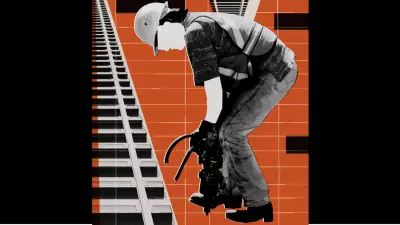ProPublica is a nonprofit newsroom that investigates abuses of power. Sign up to receive our biggest stories as soon as they’re published.

On a hot July afternoon in 2018, Gregory West found himself trudging through the mountains of northern Tennessee on what would be the last walk of his life.
The engineer and his conductor had been stuck behind a stalled train that had not budged by the end of their shift, and rail company officials told them to walk out to a road where a vehicle could meet them. It would be an hour’s journey up and down steep hills in 88-degree heat. And West, 57, had to lug two large bags of his belongings the entire way. Just as he reached the rendezvous point, he collapsed. The Campbell County medical examiner said West had pneumonia and hypertension, which decreased his oxygen supply before he died. His sister sued the railroad company, CSX, which settled with her for an undisclosed amount.
But none of that is reflected in CSX’s worker injury statistics. ProPublica only found out about it while reviewing lawsuits levied against the nation’s largest freight carriers in the past 15 years. West’s was one of at least 130 worker deaths and other injuries that were alleged to have happened on the job but that railroad companies never reported to regulators.
Among the others, according to the lawsuits, were a CSX conductor who suffered a fatal heart attack after doing physical labor on a subfreezing overnight shift and a contractor who lost three fingers rigging equipment in a Norfolk Southern rail yard.
The Federal Railroad Administration requires companies to report such incidents because knowing about them allows officials to spot broader lapses and hazardous working conditions. The agency’s statistics are the main way the public can view the businesses’ safety records, for which they must answer to their employees’ unions and their shareholders.
But, as ProPublica has previously reported, railroad companies go to extreme lengths to portray themselves as safer than they really are — retaliating against workers who report defects and silencing those who get injured. Officials with the FRA have said there is not much they can do about the forces — like the financial implications of appearing to admit liability and a culture that faults managers when employees get hurt on their watch — that can drive companies to quash injury reporting.
This tranche of missing injuries and deaths, however, exposes the clearest failure by regulators to hold companies accountable.
Much of the problem stems from the FRA’s porous reporting policies, which ProPublica found provide opportunities for companies to hide work-related injuries and deaths. Officials say they have spent the past five years working on revisions, which they plan to unveil this year. They said disclosing the details now would be a breach of the rulemaking process, but they mentioned that their changes could address issues raised by ProPublica’s reporting.
ProPublica’s findings show the powerful rail companies have long benefitted from loopholes.
“The system is rigged, especially when it comes to injuries. … You see what they want you to see.” — Jared Cassity, union leader
Though agency officials say they are aware of conflicts of interest that steer railroad companies toward keeping worker injuries quiet, FRA policies give the businesses broad latitude to determine whether injuries and even on-the-job deaths are work-related — and, thus, whether they need to be reported.
One reason companies give for opting out of reporting: Rail company officials believe a worker is lying, an argument the companies have made in court, and one juries and judges have sometimes rejected.
The agency also doesn’t require railroad companies to report certain injuries and deaths of contractors who are crushed or maimed by trains. Those incidents are supposed to be reported to a different agency by the contractor’s employer, which doesn’t tie them to the railroad’s record or allow them to be easily studied for possible safety reforms.
Empowered to levy fines up to $10,000 against companies that willfully fail to report injuries, and even to disqualify managers who do so, FRA officials say they will not be investigating the scores of unreported cases ProPublica provided them in a database — cases they confirmed were nowhere to be found in their records.
The bulk of the cases ProPublica found, including the deaths, happened more than five years ago. The FRA says it does not have the power to punish railroads for unreported injuries after that much time or even edit the safety record to reflect them. It attributes that to a law that applies to all federal regulators.
And though 11 of the alleged injuries ProPublica raised are newer — in two unreported cases, workers said they were fired after being hurt — officials said those won’t be reviewed either. They view lawsuits, which ProPublica used to find the cases, as “unreliable” sources of information.
The FRA is satisfied with its standard process for unearthing hidden injuries, an audit done of each rail company every two years. As part of these four-month deep dives, regulators say they pore through internal company documents to find injuries that were deemed unreportable, then review medical records and interview employees to determine whether the injury should, in fact, have been reported.
Officials didn’t have an explanation for how audits missed the two deaths ProPublica found and said they should have been submitted to the FRA based on the information reporters provided. “Despite our best efforts, regrettably there are cases of failures to report or to accurately capture all covered events,” the agency said in a statement, adding that “any gaps or voids in reporting are of concern and will prompt us to redouble our efforts,” that it expects companies to “faithfully abide” by the requirements and that it strives to continuously improve its data collection and validation.
Each of the railroads denied that they failed to report injuries, largely claiming that the cases either didn’t meet the reporting guidelines, as CSX argued about West’s death, or that the company didn’t believe the worker’s injury happened at work. “Those cases where CSX determined the events were not reportable are fully supported by the facts and evidence gathered by CSX through its thorough investigations of each incident,” the company said in a statement, adding that it was proud of its “best in class” reporting process and that it complies with FRA’s audits.
The Association of American Railroads, the industry’s lobbying arm, denied that underreporting is widespread and called ProPublica’s findings isolated incidents. The association pointed to the most recent injury statistics — the ones ProPublica has found are incomplete — to show the rails are the safest they have ever been.
But union leader Jared Cassity said ProPublica’s findings are further evidence that companies’ safety records do not capture the full range of dangers allowed to persist on the rails. “The system is rigged, especially when it comes to injuries,” said Cassity, the alternate national legislative director for the International Association of Sheet Metal, Air, Rail and Transportation Workers, or SMART.
“You see what they want you to see,” he said.
To find unreported injuries and deaths, ProPublica reviewed more than 5,000 federal lawsuits levied against the nation’s six largest freight railroad companies, the so-called Class 1s, from 2009 to 2022. For each complaint that mentioned a worker injury or death and had a detailed enough description of what happened, ProPublica consulted a 300-page FRA guidebook to determine which cases appeared to fit reporting requirements. Then, journalists combed through the agency’s online railroad injury database to see whether the incidents had been reported and, if not, asked the agency to double check its files.
Clear patterns emerged in cases that weren’t reported.
Unlike trauma deaths or amputations, the vast majority of unreported injuries were open to easier arguments that they were not work-related — sprained ankles, torn rotator cuffs, tweaked backs, strained tendons. One man said he had been in a port-a-potty when a track hoe struck it; another said he was hurt when the railroad’s transport vehicle crashed. One said he slipped along the ballast, the gravel that surrounds train tracks; another said he jumped from a train to avoid a collision.
Broadly speaking, railroads must tell the government about any on-the-job injury that requires medical care beyond diagnostic procedures like X-rays, that requires an employee to miss a day of work, or that lands an employee on light duty.
But rail officials have long found ways to argue that these less-visible soft-tissue injuries, unlike gaping wounds, could have happened off duty or for reasons not related to the work employees were doing.
“The guide gives us the right to make our best guess on a case, and then [the FRA has] to prove us otherwise,” said Tuesdi Sweatt, CSX’s then-senior manager of accident reporting and compliance, in a legal deposition in 2018.
BNSF engineer Scotty Bragg was operating a train near Hardy, Arkansas, on Nov. 17, 2021, when he said he encountered rough track and “experienced significant jostling” in a cab that didn’t have seatbelts. He said he injured his neck, back and spine, requiring surgery. A company official said in a deposition that a review of locomotive footage led officials to decide that Bragg hadn’t encountered rough track and wasn’t injured at work.
It was a familiar argument used against hurt workers. ProPublica has reported on cases in which companies presented video evidence that did not hold up to scrutinyin court, failing to convince juries that an employee was wrong or lying. At least two of these cases resulted in multimillion-dollar payouts to the workers. Despite the company’s denial of Bragg’s injuries, it did agree to settle his case. BNSF’s response did not address any of the unreported cases ProPublica sent the company in a spreadsheet along with an interview request.In a statement, BNSF said it takes its reporting obligations seriously and touted its safety record, which over the last decade, “produced the lowest number of injuries in our railroad’s history.”
The FRA allows companies to decide whether an injury was job-related or not, even when an employee dies at work.
“You certainly want events that occur at work to be reported for the agency to consider whether or not they deserve further investigation, and that will include heart attacks and asthma. … And by aggregating information from these investigations, it allows researchers to go in and use the data to better understand what’s going on in these workplaces.” — David Michaels, former head of the Occupational Safety and Health Administration
In the case of West, the engineer who died in the mountains, the company said that because he suffered from a “personal condition,” his death didn’t have to be reported. In court, the company said West “suffered from multiple maladies and physical conditions, and as a result, it was not foreseeable” that a “one-half mile walk would cause or contribute to his death.”
The FRA said that even if companies don’t file reports, they must phone in all on-the-job deaths to the U.S. Coast Guard’s National Response Center, no matter the cause. But it is unclear what happens once the agency is contacted; these calls don’t become a part of an official injury record and it’s unclear what trend analysis, if any, is done with them.
CSX conductor Danny Byrom, 37, was working an overnight shift in an Illinois yard on Jan. 27, 2019, while the temperature was around 20 degrees. He bent over to remove a heavy piece of equipment. Afterward, he collapsed and died of cardiac arrest.
When asked about the case, FRA officials said it should have been reported because there was “probably a causal connection” between his work-related exertion and his death. CSX told ProPublica the company believes Byrom’s death wasn’t reportable because he suffered from a “personal condition.” His family’s lawsuit against the company is ongoing.
Agency officials said nontrauma deaths that appear to be natural aren’t likely to immediately spur a full investigation.
The omissions of these kinds of deaths from companies’ safety records — and the lack of any kind of investigation by the FRA — troubles Cassity, the union leader, because the deaths appeared to be related to work tasks. “You’re being forced to do it, and you die in the performance of it. … The fact they don’t consider that is … it’s unconscionable.”
The FRA should investigate all on-the-job deaths, he said, and determine itself whether they were work-related.
Such reporting would help the agency identify and eliminate hazards for workers, said David Michaels, former head of the Occupational Safety and Health Administration, which oversees injury and death investigations in most industries outside the rails.
“You certainly want events that occur at work to be reported for the agency to consider whether or not they deserve further investigation, and that will include heart attacks and asthma,” said Michaels, who is now a professor at George Washington University. “And by aggregating information from these investigations, it allows researchers to go in and use the data to better understand what’s going on in these workplaces.”
Had West and Byrom worked at a bank, or a restaurant, or some other American workplace, OSHA would have considered their deaths reportable, Michaels said.
But ProPublica found the plight of workers who are injured by trains — but who are not staff members of rail companies — may be even worse.
Kenneth Ivy was working for Riceland Foods at the company’s Jonesboro, Arkansas, rail yard in November 2013 when he said he noticed a Union Pacific freight car had been placed on a slope without its brakes applied. He said he attempted to apply the brakes and they wouldn’t work. The freight car rolled over Ivy, crushing part of his left arm and both his legs, which had to be amputated.
Because Ivy didn’t work for the railroad and the accident didn’t happen on Union Pacific land, government policies dictated that Union Pacific didn’t have to report it to the FRA. Instead, Riceland Foods reported it to OSHA. So now Union Pacific’s safety record doesn’t reflect the fact that its freight car grievously injured someone, nor did the regulator with expertise in rail safety investigate whether the brakes were faulty, nor could the agency use the incident to track similar injuries or learn whether there are any systemic hazards.
Union Pacific, which denied in court that the brakes were defective, said the worker tripped when he attempted to apply them to the moving freight car. The company noted to ProPublica that it was Riceland Foods that moved the rail car and Riceland Foods that was responsible for the switch operations. While that company settled with the injured worker, so did Union Pacific.
Though rail companies must report when contractors are hurt on their land, ProPublica found they have dodged that reporting requirement, too.
Contractor James Wheeler was rigging down a boom of heavy equipment in Norfolk Southern’s rail yard when a fellow contractor’s mistake resulted in Wheeler having three fingers on his right hand amputated. Norfolk never reported it, despite the fact that the incident happened on its land. The company did not comment on the case, but said it reviewed all of the unreported cases found by ProPublica and wound up reporting one of them to the FRA, “which was based on information added to a case months after the initial report was made internally. That update was made immediately.”
FRA officials said they believed the incident should have been reported, but because the injury happened in 2016, they told ProPublica that nothing further had to be done. The FRA said the five-year limit was a reasonable time frame.
The agency says it focuses its efforts on newer injuries and that its audits are rigorous and successful. Last year, the process caught Union Pacific managers hiding nearly 100 injuries that should have been reported.
“UP documentation clearly showed these incidents were reportable injuries,” the agency said. The company disciplined those involved, the FRA said, but the agency’s investigation is still open because a key witness in the case has filed an OSHA complaint against Union Pacific and won’t speak to the FRA until given clearance by his attorney. An agency spokesperson said the FRA expects to issue violations but as of now no fines have been levied. “Allegations that managers are incentivized to hide or ignore injured employees are false,” UP told ProPublica in a statement. The company also told ProPublica that its own audit process had found the “incorrectly classified” injuries and that the company had corrected them.
Agency officials said that most of the time, when they catch unreported injuries, they simply ask officials to reconcile the matter. The agency doesn’t separately track fines it gives for injury reporting violations, instead lumping together all the fines it levies against railroads for all kinds of reporting failures. ProPublica added up these kinds of fines levied against all Class 1 companies in 2022, the most recent year of data available. For the companies, which had $108 billion in combined revenue that year, the penalties added up to $30,011.
The agency told ProPublica it knows the penalties are too paltry to prevent the companies or their officials from attempting to hide injuries. Only Congress could increase the fines, a spokesperson said. “The proposed Railway Safety Act would allow for a substantial increase in the maximum civil penalty amount,” the spokesperson said. That bill, which received bipartisan support when it was introduced on the heels of last year’s catastrophic derailment that unleashed hazardous chemicals on East Palestine, Ohio, has since stalled in Congress.
Cassity said the FRA’s audit process allows railroads too much notice before the government arrives on site to check records. “It just just doesn’t go far enough,” he said, adding that he believes companies purposefully don’t fill out certain paperwork so they can hide injuries from the FRA and that there is little the agency can do to combat the practice.
He suggested that one way to get the fullest accounting of injuries would be for the FRA to devise a system where the reports come directly from employees. “Right now, the only way to get the facts is through a carrier that, quite frankly, is not playing fairly,” he said. “And so you’ve got to get it from the source.”
Such a system would require significant procedural and operational changes, FRA officials said, and there is no guarantee all employees would abide by them.
But agency officials said they can entertain these and other big changes during the upcoming public comment period for their proposed rules, which have not been updated since 2010. During this period, railroad companies and labor groups are expected to provide their perspectives and could mount legal efforts to change the proposals. According to the agency, any new rules will receive final approval from its chief safety officer.
Research was contributed by Jeff Kao, Mollie Simon, Mariam Elba, and Ruth Baron of ProPublica, and Carolyn Edds and Miriam Pensack.







